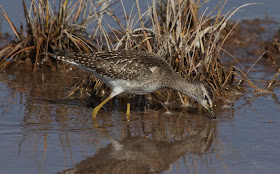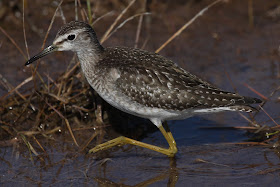Wood Sandpiper- October 22, 2012- Jamestown, Rhode Island- On Oct 13, Carlos Pedro (again) found another rarity, a Wood Sandpiper in
Code-1 and Code-2: Regularly occurring North American avifauna.
Includes regular breeding species and visitors. There is no firm designation between Code-1 and Code-2 species, except that logically Code-1 species are more widespread and are usually more numerous. Code-2 species have a restricted North American range, are more widespread, but occur in lower densities, or are quite secretive making their detection often difficult. We readily acknowledge that some Code-2 species are harder to find than some species that have higher codes.
Includes regular breeding species and visitors. There is no firm designation between Code-1 and Code-2 species, except that logically Code-1 species are more widespread and are usually more numerous. Code-2 species have a restricted North American range, are more widespread, but occur in lower densities, or are quite secretive making their detection often difficult. We readily acknowledge that some Code-2 species are harder to find than some species that have higher codes.
Judging by the number of birders that descended (and continue to) on Jamestown, and the fact that this is only the seventh sighting in the lower forty-eight, I think everyone there may have a different opinion on this bird’s “Code” status.
For over twenty years I have driven through the Meadows on North Road (causeway) heading to one of Jen and my favorite birding spots: Beavertail Point SP. Beavertail is one of the best locations in Rhode Island (for CT birders) during the fall and winter to watch for seabirds and seaducks especially on the days when the easterly gales drive the seabirds close to the Point. Jen and I have spotted Gannets, Shearwaters, Red-necked Grebes, Razorbills, Black Guillemot, Dovekie, King Eider, Harlequin Duck, Iceland
During the week I was reading all the reports of the bird as it continued to entertain birders from as far away as Michigan and the Carolinas . I was teaching an art class all week, so I wasn’t able to drive to Jamestown Rhode Island
On an embarrassing note: after twenty years of traveling down this road, I never knew where the WTP building was. Being so focused on getting to Beavertail, I passed by the big red brick building without ever knowing that it was there.
I arrived at 7:30 am and parked near the Water Treatment Plant. Since the bird was generally seen at the northeast corner of the eastern half of the marsh early mornings and late afternoons, I decided that would be the best place to start. I walked to the northeast corner of the marsh and found out that I had missed the bird by ten minutes. John Tobin, a birder from Maine
We were joined by another birder fromMaine
We were joined by another birder from
We decided to try the northwest corner of the marsh on the western side of the marsh on the other side of North Road Philadelphia who have a cottage in Rhode Island
As I mentioned, the bird was hunched in a relaxed posture. Its head looked squarish and long, bill was medium length and a bit heavy at the base, the body looked short and chunky, the wing projection was of equal length with the tail, and since the bird was wading in shallow water, we couldn’t see how long its legs were. At first it resembled a White-rumped Sandpiper with short wings. Even in the poor lighting you could see a heavily marked chest which made it look more like a Pectoral Sandpiper. Making identification even more difficult, when the bird walked near the Greater Yellowlegs that were assembled on the mudflat, this bird looked much smaller small by comparison.
As we adjusted our positions to get a better angle on the bird (because of the bright sun) it became clear what the (small) bird was: the smaller bird was the Wood Sandpiper. At that minute, in my mind I was hoping for closer and better views of the bird, I really wanted see and photograph this bird up close; to experience the intricacies of its delicate plumage. I knew in my heart that I would be carving a decoy of this bird, just needed to make mental field notes of its bill shape, plumage markings, etc. Photographs are helpful, but the field notes develop the best inspired work. But even with less than ideal scope views, I was happy to be experiencing this rare bird.
I called John to let him know that we had located the bird, but unfortunately, his voicemail picked up instead. The Sandpiper flew off and circled the pond twice landing again n the mudflat joining the Yellowlegs.
After fifteen minutes we were joined by a Father and son from Maine
The Father and son, and John walked over to Zeeks, and they motioned to me that they found it! I yelled to Chip who was just about to get into his van. The panne behind Zeek’s was much closer; about sixty yards, and of course the lighting was much better. The five of us could see the bird beautifully. The sun painted a beautiful painting with a clear Cerulean Blue sky, Raw Sienna and Yellow Ochre marsh grass framing the subtle earthy Umber tones of the bird’s plumage.
We watched the bird for a while and other birders from Rhode Island , Connecticut and Massachusetts
But my view into the panne was perfect offering me great views even when the bird wasn’t visible to the others at Zeek’s. I was careful not to disturb the bird, but in reading many of the posts and blogs by some of the photographers, they mentioned that the bird didn’t pay too much attention to them and would often walk within feet of them. But still, I was cautious.
After fifteen minutes, the bird took off and flew across the marsh, I lost sight of it.
When I joined the other birders back at Zeek’s, they followed the bird as it flew to the northwest corner of the marsh on the other side of the road. The Father and son, and Chip having great looks and wonderful experience with the bird, said good-bye and left for home. I decided to take a walk to the northwest corner to try and locate the bird. As I was walking across the causeway, I met another birder and told him where the bird had gone. His name was Ben Porter from Mass.
The bird walked through the small panne and got much closer feeding all the way. John, Ben and I watched the bird for five minutes marveling over the fact that we had such close views right near our parked vehicles. It stayed for five minutes when a large truck drove over the causeway, causing the bird to take off.
It flew over the road to the eastern side. We re-located the bird in the main pond on the far bank. It was now associating with the seven Greater Yellowlegs.
It flew over the road to the eastern side. We re-located the bird in the main pond on the far bank. It was now associating with the seven Greater Yellowlegs.
It stayed there for ten minutes and then flew back to the shallow panne behind Zeeks. Watching the bird again for some time behind Zeek’s I was satisfied. Having had good long (fairly close) looks at the bird and being able to take a few half-way decent photos, I decided to call it a day! Just as I got to my truck near the WTP, I looked up to see that the sky was filled with birds. I knew that something had spooked the birds and I thought maybe a Peregrine? However the reason why became quite clear as a Bald Eagle was drifting over the marsh riding the wind from the northwest. The presence of this large bird of prey scattered all the birds in the marsh: Yellowlegs, Mallards and Black Ducks, Herons, Egrets, Cormorants and the Wood Sandpiper. All the birds left the marsh (and returned later) but the Sandpiper circled the marsh and then landed again in the panne behind Zeeks.
While in the area, I decided to grab a quick lunch and then drive around Beavertail for a quick look. The Park was mobbed with people enjoying the beautiful day, so I decided to drive through and head home. When I got back to Zeeks, more birders had shown up and although the bird was in the panne, it was pulling its disappearing act again. No one was sure if the bird had flown off or was hiding behind the grass again. One of the birders I met was from the area, Capt. Ed Hughes. We talked a bit and then the bird took off and then flew over the marsh again heading for the northwest corner. But this time it landed behind the sandbank at the mouth of the creek. We were quite surprised that the bird decided to land in the open area in the gusty wind.
It stayed there for fifteen minutes, and again flew back and landed in the panne behind Zeeks. At 1:45 pm, most of the gathered birders had left except Capt. Ed and two others.
The bird again disappeared in the panne so I walked down to the Phragmites to see if I could locate it which I did.
A few minutes later the remaining birders left, so Capt. Ed joined me near the panne. The bird worked the opposite side of the panne, so we decided to get closer to the panne for better position hoping the bird would get closer. That’s just what it did. Within minutes, the Sandpiper walked our way.
Before we realized it, the bird was within eight feet of us! At one point the bird was too close for our lenses, we had to slowly back up so we could fit the bird in our viewfinders! Amazing!! What a spectacular bird!!
Eventually the Sandpiper walked away from us, and we left carefully not to disturb the bird.
From the parking area near Zeeks, another birder showed up and we pointed out the bird for her. She was very happy indicating that she had driven for two hours to see the bird and it was a "lifer" for her. The bird stayed in the panne behind Zeeks and then flew around the marsh with the seven Yellowlegs as I was driving away.
It eventually returned to the panne behind Zeeks. I want to personally Thank Bob Weaver and Paul L'Etoile for their great tips for finding the bird, and to Carlos of course for finding it for everyone!
Other highlights: Mallards, Black Ducks, a pair of fly-by Green-winged Teal, Greater Yellowlegs, Sharp-shinned Hawk, Coopers Hawk, 2 Kestrels, 3 Merlins, Bald Eagle, Great Blue Herons, Great Egrets, D C Cormorants, Sharptail Sparrows, Goldfinches, Yellow-rumped Warblers, and a Meadowlark
Keith Mueller
Killingworth, CT http://kmuellerart.blogspot.com
Other highlights: Mallards, Black Ducks, a pair of fly-by Green-winged Teal, Greater Yellowlegs, Sharp-shinned Hawk, Coopers Hawk, 2 Kestrels, 3 Merlins, Bald Eagle, Great Blue Herons, Great Egrets, D C Cormorants, Sharptail Sparrows, Goldfinches, Yellow-rumped Warblers, and a Meadowlark
Keith Mueller
Killingworth, CT http://kmuellerart.blogspot.com
















































































































